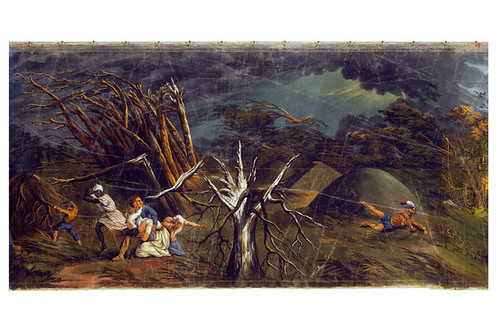
PREV ARTICLE
NEXT ARTICLE
FULL ISSUE
PREV FULL ISSUE
MONTROVILLE W. DICKESON'S PANORAMA ON DISPLAY IN ST. LOUISBob Leonard writes: The St. Louis Art Museum is displaying a 348-ft Panorama once exhibited by pioneer numismatic author Montroville W. Dickeson. The exhibit runs through September 3. Dickeson hired artist John J. Egan about 1850 to paint 25 scenes--each 14 ft long--to illustrate his archaeological lectures. (There is probably no numismatic content, but the other achievements of noted numismatists are always of interest.) I have not seen this myself, and won't be able to due to various conflicts. Maybe someone can submit a report, though.

Bob pointed me to a June 27th Wall Street Journal article about the exhibit. Here is an excerpt. And here's a QUICK QUIZ for readers - what is Montroville W. Dickeson's connection to numismatics?
-Editor
A few years ago, the Saint Louis Art Museum dug into its storerooms and saw a work that it had purchased in 1953 but not shown since, with some reason. "The Panorama of the Monumental Grandeur of the Mississippi Valley"-the only remaining of six known Mississippi River panorama paintings-was in terrible shape. Measuring 90 inches wide by 348 feet long, it was commissioned about 1850 by an eccentric amateur archaeologist named Montroville W. Dickeson, a physician by training who had excavated dozens of ancient sites along the river in the late 1830s and 1840s. Dickeson wanted a portable prop for his speaking engagements, and panoramas, which took people to places they'd likely never see for themselves, were popular entertainments of the era. So he hired artist John J. Egan, an immigrant from Ireland, to paint 25 scenes, each 14 feet long, informed by his archaeological field drawings and fanciful ideas about North American history. Dickeson's "moving panorama" wasn't meant to be shown in the round, like the famous 359-foot-long Gettysburg Cyclorama depicting the Civil War battle, or even all at once. Rather, as Dickeson performed, each scene in the panorama, strung between two vertical rollers, was cranked into place. Wall panels in the galleries also provide an introductory text and, more important, illustrations of each scene in preconservation condition. There is also a display of three field drawings and five artifacts from Dickeson's digs. Dickesen declared the best one, a small sandstone Mississippian human effigy pipe, dated 1200 to 1500, "a pipe of peace," which experts say is a speculative interpretation at best. Such conjecturing was Dickesen's folly, and his quirky views run through the panorama. Scene 2, titled "Circleville Aboriginal Tumuli; Cado Chiefs in Full Costume; Youths at Their War Practice," is completely made up, says Janeen Turk, the senior curatorial assistant in charge of the exhibition-Caddo Indians lived in Texas, not along the banks of the Ohio and Mississippi rivers as shown. Scene 11, a view of the tornado of 1844, shows the unlikely juxtaposition of an African-American woman fleeing, a white family crouched down in horror, and an Indian hanging on to the grass for dear life. In the background are flying branches and Indian mounds. Dickeson loved drama, and ordered Egan to create it. As a historical document, the panorama leaves much to be desired. As art, it may be Egan's best work, but that's not saying much. Yet those verdicts are not the point. The panorama is a relic: It shows today's viewers what 19th-century archaeology entailed and what visual entertainment was like in the 1850s, long before the emergence of technologies that limn the world today. That's why, when the conservation is completed, the museum plans to install the panorama in its permanent collection galleries. A facade wall will hide the roller mechanism, and viewers will see each scene, one at a time, as if Dickesen were still creating his show. Every now and then, a new scene will be rotated into view.
To read the complete article, see:
A Wider View of Things
(http://online.wsj.com/article/SB10001424052702303836404577474852766704394.html)
The Numismatic Bibliomania Society is a non-profit organization promoting numismatic literature. See our web site at coinbooks.org. To submit items for publication in The E-Sylum, write to the Editor at this address: whomren@gmail.com To subscribe go to: https://my.binhost.com/lists/listinfo/esylum All Rights Reserved. NBS Home Page Contact the NBS webmaster 
|